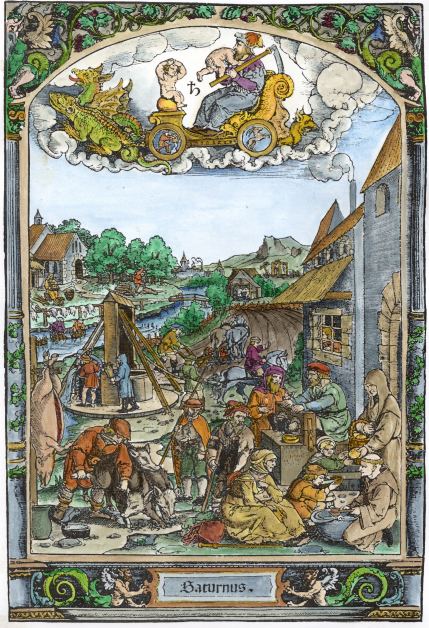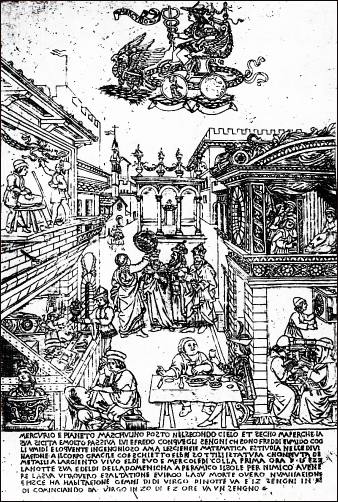
|
|
Alchemy Academy archive June 2004 Back to alchemy academy archives. Subject: New study on Splendor Solis From: Rafal T. Prinke Date: 9 June 2004 Dear All, I have just learnt about a new book on Splendor Solis: Jörg Völlnagel Splendor solis oder Sonnenglanz : Studien zu einer alchemistischen Bilderhandschrift München [u.a.] : Dt. Kunstverl., 2004 198 S. : zahlr. Ill. ; 27 cm Kunstwissenschaftliche Studien ; 113 EUR 68,- There was an article on it in "Der Spiegel" which I have not seen, but there is an English summary of it on-line which I quote here in extenso: --------------------------------------- "Fire in the Phial" Middle Ages: Fountains of youth, elixirs, transmutation - a researcher has succeeded in deciphering Europe's most famous book of magic. Twenty copies of the treatise "Splendor Solis" have turned up so far. But who wrote it? Until now, neither the author nor the artist have been identified. Now at last there is a lead. Equipped with patience and a magnifying glass, the Berlin art historian Jörg Völlnagel, 36, has been studying "one of the most important secular codices". He has found that the book of magic originated in the region of Augsburg; the "original" was written in 1531/32; and the drawings were painted by Jörg Breu the Elder, known for his blasphemous attacks against the church and the state. ---------------------------------------- Besides the probable authorship, the interesting thing to note is that 20 copies are mentioned, as compared with 7 known to Hartmut Broszinski (Lux lucens in tenebris Splendor Solis oder Sonnenglanz) in 1994. Best regards, Rafal Subject: New study on Splendor Solis From: Stanislas Klossowski de Rola Date: 12 June 2004 I would like to see more of this new Splendor Solis study. I cannot offhand subscribe to the new authorship for the illustrations. It is indeed unfortunate that my own research was shelved by Thames & Hudson due to the prohibitive costs at the time of a two volume edition containing a complete facsimile of the London MS with a commentary volume on all the other noteworthy copies. There are probably twenty if one counts all the inferior copies extant. As to the authorship of the paintings it is my staunch belief that their original design should be ascribed to Albrecht Glockendon who published the original planetary series. As I have written elsewhere the text is a compilation and a paraphrase from and of other sources such as the Turba and above all Aurora consurgens. The alleged author Solomon Trismosin (in the published versions) is a transparent anagram signifying the wisdom of the triple stone. i.e. solomon = the wisdom of and tris like trismegistus triple mosin= simon=peter = stone. Furthermore this compilation from ancient sources has very little if anything to do with magic. All the best Stanislas Klossowski de Rola Subject: New study on Splendor Solis From: Adam McLean Date: 18 June 2004 Dear Stanislas, I don't think this new book on the 'Splendor solis' indisputably establishes the painter of the images as Jorge Breu. The argument of Jorg Vollnage seems to me to be typical of an art historian in that he seems to make up his mind about the authorship based on some sudden insight or whatever, then spends pages and pages trying to convince us that he is right. He does survey Glockendon and Simon Bening as candidate artists for creating the work but rejects these based on stylistic grounds. I myself am not convinced that they can be so easily rejected as I was very impressed by the similarily of some of Bening's work I saw earlier this year at the Royal Academy exhibition 'Illuminating the Rebnaissance' to the 'Splendor solis'. I feel sure that the 'Splendor solis' must have emerged from people in the circle of these miniaturists who were based in Nuremberg. Jorg Vollnage instead ascribes the work to Jorg Breu (who was not primarily a miniaturist but a block book painter in Augsburg), partly on the basis of an illustration by Breu ( an ex libris) in a manuscript of 1518 now in the British Library. Vollnage argues the similarities between this and the 'Spendor solis', but I am afraid I really cannot see this as clearly as he does. He also bases his argument for the authorship of the images on the seven planetary figures the series. These have the flasks in the centre and are surrounded with charming little scenes depicting the symbolic features of the associated planet. Usually this is thought to have been linked to the famous woodcuts of Beham, but Vollnage shows another series of planetary images by Breu as a potential source. I find these are much further removed from the Splendor solis than the Beham images. (For those who don't know these I attach here one of my coloured versions of the Beham woocuts). Interestingly there is an original print of one of the Breu planetary images here in the Burrell collection in Glasgow so I will one day go and see it. This new book is a good survey of the artistic context for the 'Splendor solis', though not the alchemical context. However, I do not feel many people will be entirely convinced by the ascription to Breu. Adam McLean 
Subject: New study on Splendor Solis From: Rafal T. Prinke Date: 18 June 2004 Dear Adam and Stanislas, > He does survey Glockendon and Simon Bening as candidate > artists for creating the work but rejects these based on stylistic grounds. > I myself am not convinced that they can be so easily rejected as I > was very impressed by the similarily of some of Bening's work I > saw earlier this year at the Royal Academy exhibition 'Illuminating the > Rebnaissance' to the 'Splendor solis'. I feel sure that the 'Splendor > solis' must have emerged from people in the circle of these miniaturists > who were based in Nuremberg. Don't you think that it may have been another member of the Glockendon family - Nikolaus? This authorship is actually assigned to it by publishers of this facsimile: http://www.patrimonio-ediciones.com/facsimiles.html There are some minatures by him from other facsimile editions of a book of hours and a prayerbook here: http://www.finns-books.com/glock.htm These are cruder than those in Splendor Solis - but in a way similar. This is of course a view of a dilettante in art history :-) Best regards, Rafal Subject: New study on Splendor Solis From: Rafal T. Prinke Date: 18 June 2004 I forgot to include one other link: > There are some minatures by him from other facsimile editions > of a book of hours and a prayerbook here: > > http://www.finns-books.com/glock.htm and the prayerbook here: http://www.finns-books.com/brandenb.htm Best regards, Rafal Subject: New study on Splendor Solis From: Stanislas Klossowski de Rola Date: 20 June 2004 Thank you Adam and thank you Rafal for your contributions. I suggest that all interested parties look at Albrecht Glockendon's planetary series which he published in 1531 and which are just like the one forwarded by Adam. Albrecht Glockendon lived in a house which if memory serves me well was called 'sonnenglantz'. He and Nicolas Glockendon painted various versions of 'Splendor solis' and Gabriel Glockendon painted the London Ms. As the son and grandson of painters I am not exacly ignorant of stylistic differences and the attributions to Hans Sebald Beham are simply inaccurate. I have the relevant documents in California and am right now in Italy so it is a little hard to put my case forward with complete accuracy but will do so after June 25th if the forum is interested. All the best, Stanislas Klossowski de Rola Subject: New study on Splendor Solis - Planetary series From: Adam McLean Date: 22 June 2004 Does anyone have access to good images of the Baccio Baldini planetary series which is similar to the series in the 'Splendor solis' ? The Baldini engravings were done around 1460 thus long before the 'Splendor solis' was conceived. Does anyone know a good source for these Baldini images, an article in a journal or some printed book, as I would like to study them in more detail ? I attach the image of Mercury. Adam McLean 
Subject: New study on Splendor Solis - Planetary series From: Marisa Addomine Date: 22 June 2004 Dear Adam, There is an exhibition currently held in Pavia, as you can see at the link: http://www.comune.pv.it/museicivici/mantegna/mantegna.htm about Mantegna, but the series of the Planetes of Baccio is there too, in one of the most well-preserved samples set. Electa, that you can reach at: www.electaweb.it is the best Italian art catalogue publisher, and they will have (or already have) the complete catalogue of the exhibition. Best regards, Marisa Addomine Subject: New Book - translation of Ibn Umail From: Adam McLean Date: 24 June 2004 Recently I received, through the kindness of one of the academy members, a copy of an interesting book. Book of the Explanation of the Symbols, Kitab Hall ar-Rumuz by Muhammad Ibn Umail. Edited by Theodor Abt, Wilferd Madelung and Thomas Hofmeier. Translated by Salwa Fuad and Theodor Abt. Living Human Heritage Publications, Zurich. 2003. ISBN 3-9522608-1-9 www.livinghumanheritage.org Foreword Introduction 1. The corpus Alchymicum Arabicum (CALA) 2. Muhammad Ibn Umail and his significance for our time 3. Hall ar-Rumuz a synoptic view 4. The edition 5. The translation 6. The corpus Alchymicum Arabicum (CALA) Overview of the manuscripts of the Hall ar-Rumuz Book of the Explanation of the Symbols by Muhammad Ibn Umail Text in Arabic and English Facsimiles This is the first volume in a series entitled Corpus Alchemicum Arabicum One can only hope that this series will be able to provide us with many more translations of key works of Arabic alchemy. |